NFL teams are no strangers to losing good players each offseason — that’s the very nature of a salary-capped sports league. And while the league provides various mechanisms to help teams retain their top players — namely the franchise and transition tags — clubs can only use one of these tags each offseason, so it’s impossible for them to keep all of their stars on the roster.
Some losses are bigger than others, and teams have to gauge the quality of depth on their roster at each position to determine who their priority free agents are. They may (should) also balance their NFL draft plans with their free agency philosophy.
Ultimately, every team is going to lose a contributor or two from the 2020 NFL season. Here’s who we think could be the biggest loss for each of the 32 NFL clubs.
ARZ | ATL | BLT | BUF | CAR | CIN | CHI | CLE | DEN | DAL | DET | GB | HOU | IND | JAX | KC | LVR | LAC | LAR | MIA | MIN | NE | NO | NYG | NYJ | PHI | PIT | SF | SEA | TB | TEN | WFT
ARIZONA CARDINALS: EDGE/LB Haason Reddick
The Cardinals drafted Reddick with the 13th overall pick of the 2017 NFL Draft, but the returns were very poor through his first three seasons. Reddick produced PFF grades of 54.0, 60.4 and 40.2, respectively.
Arizona finally moved the former Temple Owl from off-ball linebacker to a pure edge rusher this season, and the high-level play they were hoping for soon followed. He graded out at 72.8 overall and recorded an impressive 82.6 pass-rush grade, the 11th-best mark among all edge rushers who played at least 100 snaps.
The Cardinals ranked 21st in team pass-rush grade in 2020; the team's defensive line collectively won only 42.7% of their pass-rush snaps, which ranked 20th. The loss of All-Pro pass-rusher Chandler Jones undoubtedly played a big role. And while Arizona acquired Markus Golden — a former second-round pick of the Cardinals in 2015 — from the Giants in a deadline trade to help with Jones’ absence, he will also be a free agent this offseason after a solid enough year in his role.
The Cardinals have to see what they have in Reddick as an outside linebacker with a full offseason ahead to take his game to the next level.
ATLANTA FALCONS: S Keanu Neal
With former Atlanta Falcons head coach Dan Quinn now installed as the Cowboys' new defensive coordinator, we can already envision a safety tandem of Xavier Woods and Neal in Big D. Both players are free agents and would need to be re-signed, but Woods manning the deep third at free safety and Keanu Neal playing down in the box at strong safety would make a great pairing for the Cowboys.
Atlanta exercising the fifth-year option for Neal, despite some of the injuries he’s dealt with, shows how much confidence the team has in him being a difference-maker down in the box when healthy. Neal ranked ninth among all safeties in pressures in 2020 (10); he was also the first player to contact the ball carrier on 88 plays this season, second among safeties, and he finished fifth in tackles for loss or no gain with nine.
BALTIMORE RAVENS: CB Jimmy Smith (extended through 2021 on Jan. 1)
The Ravens have a pair of franchise-tagged edge rushers set to hit free agency in Matthew Judon and Yannick Ngakoue, but Baltimore is no stranger to losing edge rushers. Za’Darius Smith departed for the Green Bay Packers after the 2018 season, and the Ravens didn’t miss a beat in 2019 — they prioritize spending in the secondary, as they’re a clear believer in the immense value of coverage.
Smith has been tremendously valuable for the Ravens since being selected 27th overall in the 2011 NFL Draft, allowing a passer rating of only 75.8 since entering the league. Now on the back nine of his career, Smith has become a chess piece capable of spot snaps at wide corner, slot corner and even at safety. His versatility in the secondary paved the way for Ravens star cornerback Marlon Humphrey, who actually played more in the slot this season than out wide for the second year in a row.
Baltimore was smart to bring Smith back for another season. The more talented defensive backs, the better … always.
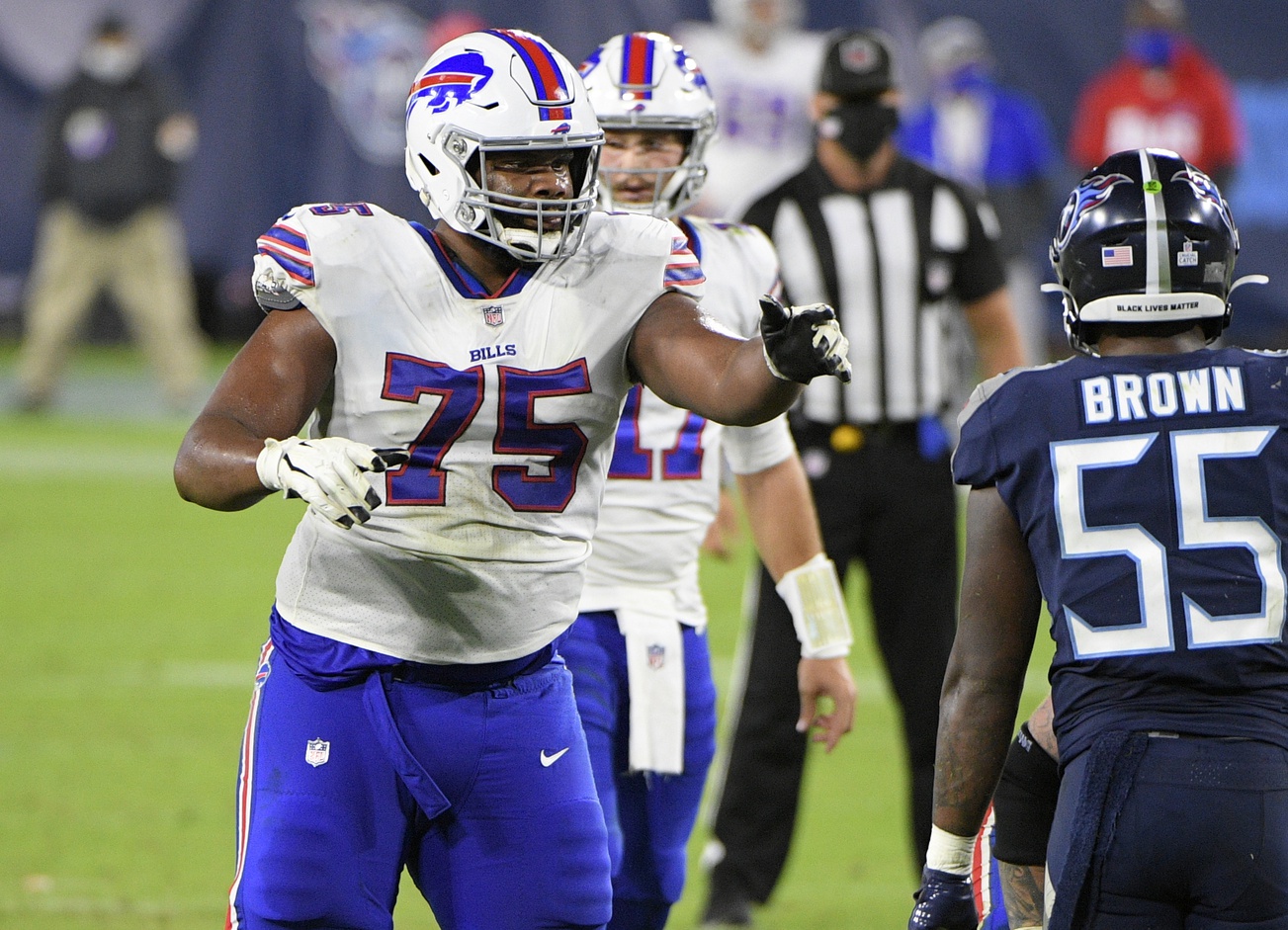
BUFFALO BILLS: T Daryl Williams
Williams has been a revelation for the Bills in 2020, reuniting with Buffalo GM Brandon Beane after Beane played a role in drafting Williams while with the Carolina Panthers. Williams never earned a pass-blocking grade below 60.9 in 2020, which is a remarkable feat of consistency for a guy who battled back from a handful of injuries early in his career.
Buffalo extended left tackle Dion Dawkins shortly before the season, though his four-year, $58.3 million extension ($14.575M APY) is quite team-friendly. There is no reason why the Bills shouldn’t look to lock up both bookends on their offensive line for the foreseeable future.
CAROLINA PANTHERS: T Taylor Moton
Both of Carolina's starting tackles are set to hit free agency, and though left tackle Russell Okung can still play at an elite level when healthy, he’s now played fewer than 500 snaps in consecutive seasons.
Moton is the future along this offensive line, and with Carolina very much in the mix to acquire a new franchise quarterback, an anchor at right tackle will go a long way toward keeping him upright. The fourth-year right tackle has graded out at 76.2 or higher for three straight seasons; he’s always been a stalwart in pass protection, but he took a huge step in run blocking in 2020, jumping from a career-high 67.4 run-block grade in 2019 to a 76.3 run-blocking grade in 2020.
Moton is one of the most important free agents to any team across the league this offseason.
CHICAGO BEARS: WR Allen Robinson II
Robinson may be the single most important free agent to any roster, as the Bears will potentially have a new quarterback under center and Robinson is one of the top safety blankets in the NFL.
As good as Darnell Mooney’s rookie season was — his 67.4 receiving grade ranked eighth among 17 qualifying rookies wideouts — the Bears shouldn't be comfortable rolling into 2021 with him as the No. 1 option. He’s a forced-missed-tackle machine, and there should be serious optimism about his future, but Chicago needs a big-bodied possession receiver like Robinson who can go up and get 50-50 balls.
No wide receiver has seen more contested targets (117) or caught more of those contested targets (61) than Allen Robinson over the last three seasons. His 94.5 PFF receiving grade on those looks ranks second to only Kenny Golladay over that span.
Beyond Mooney, the Bears don’t have NFL-caliber outside wide receivers on the roster.
CINCINNATI BENGALS: EDGE Carl Lawson
This was an extremely tough call, as both Lawson and cornerback William Jackson III deserve the acknowledgment. However, Cincinnati traded longtime star edge rusher Carlos Dunlap to the Seattle Seahawks at the trade deadline and clearly wasn’t content with their roster at that position, as they put in a waiver claim for Takkarist McKinley promptly after his release. McKinley subsequently failed a physical and was waived again.
Nevertheless, Cincinnati signaled that they wanted to bolster their edge rush, and retaining Carl Lawson is paramount just to maintain the status quo. Lawson saw a significant uptick in snaps in 2020, playing 723 with a previous career-high of 477, and his pass-rush productivity did not fall off whatsoever. In fact, he was more efficient with more playing time, with his 84.9 pass-rush grade ranking 10th among all edge rushers who played at least 100 snaps.
One other reason Lawson edges out Jackson here is that Cincinnati signed CB Trae Waynes to a three-year, $42 million contract before the 2020 season. He suffered an injury and missed the season, but he’ll be back in 2021.
CLEVELAND BROWNS: CB Terrance Mitchell
Cleveland is certainly not unaware that their secondary remains the Achilles' heel of the roster, as the Browns have invested heavily in both the safety and cornerback positions in recent years. Denzel Ward, the 2018 No. 4 overall pick, is a budding superstar at wide corner, and Cleveland followed up that pick by selecting cornerback Greedy Williams in the second round in 2019.
Williams went through the fairly typical first-year growing pains in 2019 and unfortunately missed the entire 2020 season to injury, so the Browns need to retain and add at cornerback until the unit is a strength.
Mitchell played fewer than 800 snaps combined in 2018 and 2019 but played over 1,000 in 2020 alone. Even if he isn’t a starter next year, he’s clearly proven he’s worth keeping around in a reserve role.
DALLAS COWBOYS: QB Dak Prescott
This one doesn’t need much analysis — we all saw how the Cowboys' season unfolded. Dallas may look to draft a quarterback and turn attention to the future, but if not, they need to back up the Brink's truck at the Prescott residence once and for all.
Prescott has earned a PFF grade above 72.0 in every season of his career so far and even recorded a career-high mark of 85.2 up until his season-ending injury, seventh among 34 qualifying quarterbacks over the first five weeks.
DENVER BRONCOS: S Justin Simmons
Simmons took the challenge of playing on the franchise tag head-on, finishing as the ninth-highest-graded safety in the NFL (77.4) after taking the top spot in 2019.
Simmons and Kareem Jackson form one of the league’s best safety tandems, and with Jackson set to turn 33 years old next year, it’s worth making Simmons one of the highest-paid safeties in the NFL to keep this duo together, even if it means the Broncos are spending the most money in the league at the safety position for a year or two.
DETROIT LIONS: WR Kenny Golladay
The Lions' top two receiving weapons, Golladay and Marvin Jones Jr., are set to hit free agency this offseason. The new head coach and general manager in Detroit should make it their top priority to retain Golladay.
Among all wide receivers who have seen at least 20 contested targets over the last two seasons, Golladay converted contested targets into receptions at the fourth-best rate in the NFL, with exactly two-thirds of his contested targets ending up in his hands. Michael Thomas, Corey Davis and Chris Godwin are the three wide receivers ahead of him, so he’s clearly in elite company.
GREEN BAY PACKERS: C Corey Linsley
Linsley was named a first-team All-Pro for the first time in his career this season, and that certainly is in line with Linsley’s massive advantage in terms of PFF grade among centers. Linsley finished the season with an 89.9 overall grade, 9.6 points higher than the next best center.
What sets him apart is his prowess in pass protection coupled with great mobility in Matt LaFleur’s wide-zone run scheme. There are a handful of examples around the league of centers who excel in one area but struggle in the other — Linsley is the rare talent that plays at a high level in both respects.
Nevertheless, Green Bay will have a tough time finding the money for Linsley following the massive four-year, $92 million extension for star left tackle David Bakhtiari. Wide receiver Davante Adams has one year left on his deal and will surely be looking for a gigantic payday, as well.
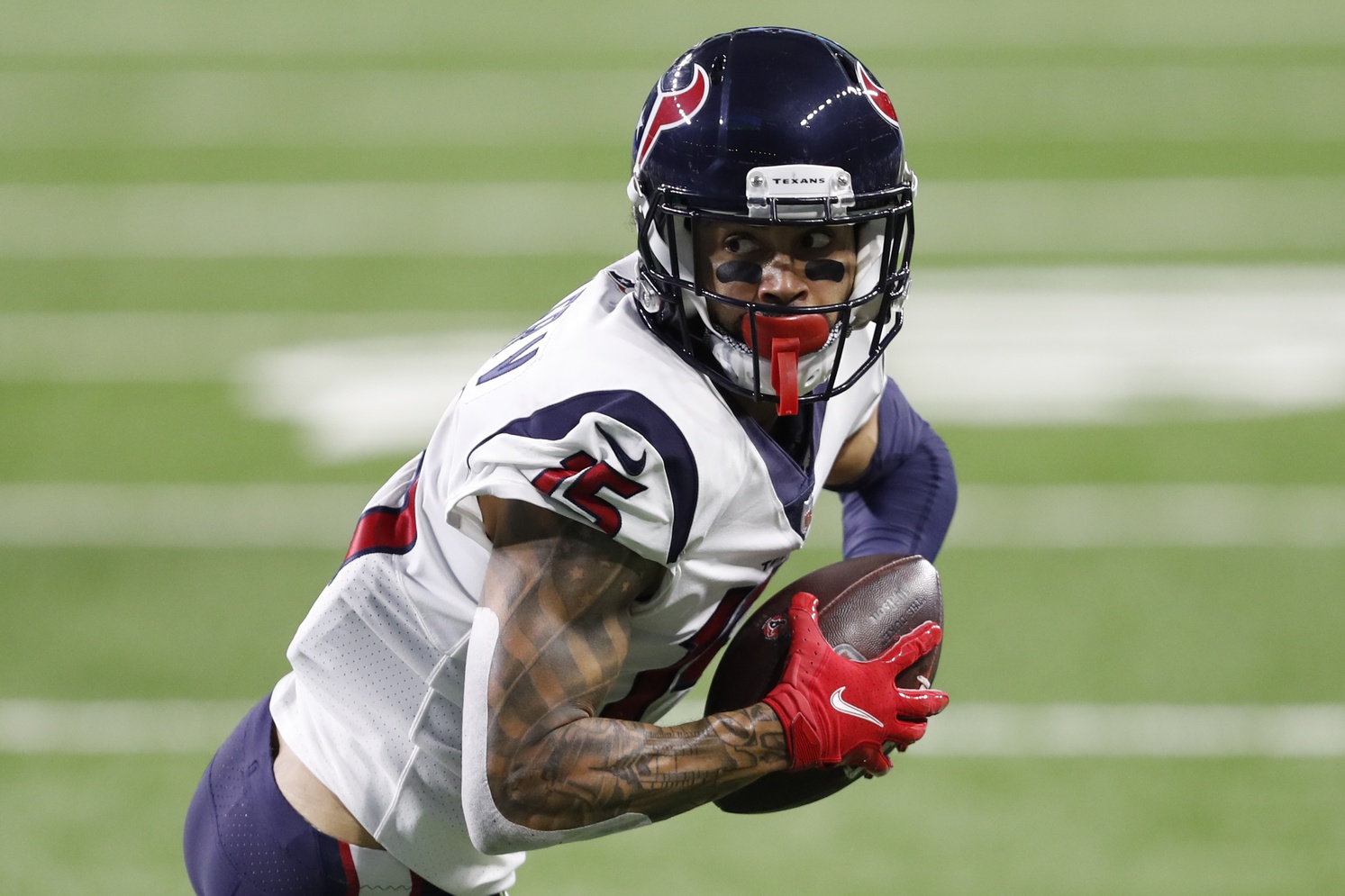
HOUSTON TEXANS: WR Will Fuller V
DeAndre Hopkins' departure didn’t hurt the Texans' offense as much as many expected, with Fuller and Brandin Cooks, who Houston traded for after sending Hopkins off to Arizona, largely filling the void.
Houston had two wide receivers finish the season ranked in the top 20 in PFF wins above replacement, which is even more impressive when you consider Cooks was brought along slowly to start the season and Fuller missed the final five games of the campaign following a suspension. The Texans can’t afford to lose their No. 1 wideout for a second offseason in a row.
INDIANAPOLIS COLTS: CB Xavier Rhodes
Rhodes’ career resurgence in Indianapolis played a major role in Indianapolis’ return to the postseason. The Colts have a star slot cornerback in Kenny Moore II and a young up-and-comer in 2019 second-round pick Rock Ya-Sin, retaining Rhodes and running it back with this group again could lead to further success as Ya-Sin continues to progress.
Impressively, the Colts really aren’t set to lose many key players. One could argue Philip Rivers should be the name here, but Indianapolis could decide to turn toward the future and find a franchise quarterback; it would be hard to argue with that logic.
JACKSONVILLE JAGUARS: T Cam Robinson
Depending on how you look at it, one of the more impressive aspects of the Jaguars' upcoming offseason is how little value they’re set to lose in free agency. We say “depending on how you look at it” because, of course, this also means they just don’t have many good players on the roster. But nonetheless, it will enable them to spend wherever the new general manager chooses.
The Cam Robinson pick here will undoubtedly be a controversial one because he has never graded all that well. His 63.4 overall mark in 2018 is the best of his four-year career — but he’s also never graded below 63.1 in pass protection.
KANSAS CITY CHIEFS: CB Bashaud Breeland
The Chiefs re-signed all their top guys after a magical Super Bowl run in 2019, so there are not many key players set to hit free agency. However, Breeland and 2020 fourth-round rookie L’Jarius Sneed combined to form one of the NFL’s top outside cornerback duos in the NFL this season, producing the No. 1 team coverage grade in the league in 2020 among outside corners.
The key part with retaining Breeland is arguably more about the contract situation, as Kansas City needs any low-cost asset they can get given the exorbitant contracts handed out to Patrick Mahomes, Chris Jones and Frank Clark, among others. Breeland’s production at a cost-effective price could be the key to repeating 2020’s impressive performance.
LAS VEGAS RAIDERS: WR Nelson Agholor
This was another tough call, as the Raiders have invested heavily at wide receiver — both in signing Tyrell Williams back in 2019 to a four-year, $44.4 million deal and in drafting Henry Ruggs III at No. 12 overall in 2020 along with Bryan Edwards in the third round.
However, Williams missed the entire 2020 season to injury and has zero dead money remaining on his contract, so odds are he may be looking for work elsewhere this offseason. Agholor would be a good replacement for the role of a pure deep threat on this team. Ruggs needs to be used more creatively around the line of scrimmage and in horizontal concepts as opposed to just running go routes. Agholor enables the Raiders to do that.
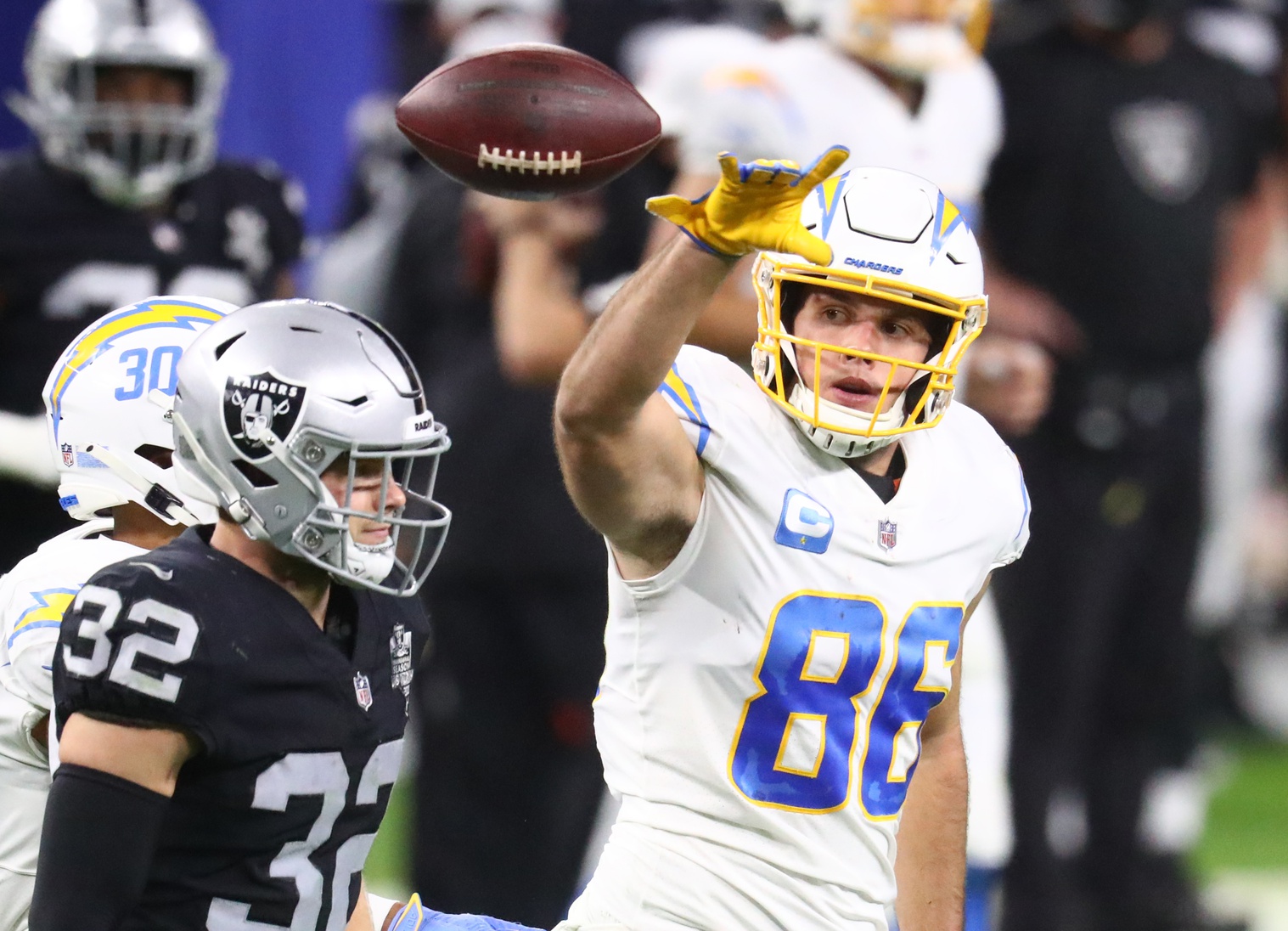
LOS ANGELES CHARGERS: TE Hunter Henry
The tight end position is still so scarce in the NFL that one could argue whenever a team finds a consistently good player at the position, they would be foolish not to retain him (barring completely unrealistic contract requests, of course).
Only eight tight ends in 2020 had 60-plus receptions (Henry being one of them), compared to 38 wide receivers. Of course, we should expect more wide receivers to put up these numbers, but with over one wide receiver per team hitting this benchmark compared to just one-fourth of teams getting the same such production at tight end, there’s clear value in finding a capable receiving tight end.
Henry's 15 first-down receptions on third down also ranked third at the position, proving his worth as a reliable target for ascending star Justin Herbert.
LOS ANGELES RAMS: S John Johnson III
Cornerbacks Jalen Ramsey and Darious Williams got the overwhelming majority of praise for the success of the Rams' coverage unit in 2020, but John Johnson III was just as important.
Johnson ranked fourth among all safeties in coverage grade in 2020, and this is no aberration. Since being drafted in 2017, he has the seventh-best coverage grade among all safeties. And defensive coordinator Brandon Staley’s innovative scheme tremendously benefits a ballhawk safety in the deep third of the field.
Notably working against this reunion, the Rams have selected a handful of safeties over the past several drafts, many of whom traditionally have played free safety. If Los Angeles can’t make a deal work, the team should still be set moving forward.
MIAMI DOLPHINS: C Ted Karras
The value of continuity along the offensive line probably gets overblown each offseason, but there’s no denying it helps to have chemistry in the trenches. The Dolphins have a young offensive line, and Karras played all 1,068 snaps this season at center for Miami with players developing around him.
Karras also had to alternate between working with both Ryan Fitzpatrick and Tua Tagovailoa and held up admirably. He’s not a top center in the NFL — and Miami shouldn’t break the bank to retain him — but a steadying veteran presence would go a long way at the right price.
MINNESOTA VIKINGS: S Anthony Harris
Harris was the subject of significant rumors at the trade deadline once the Vikings' season appeared to be all but over, but nothing materialized in a quiet market. Harris’ situation is similar to that of Justin Simmons in Denver, wherein a top veteran safety in Harrison Smith is still playing at an elite level but could be nearing the end of a Hall of Fame career.
Since the undrafted free agent turned star became a full-time starter with Minnesota in 2018, he has the second-best coverage grade among all NFL safeties (93.0).
Nevertheless, the Vikings’ cap situation will certainly pose a big challenge to this extension.
NEW ENGLAND PATRIOTS: G Joe Thuney
Thuney has been an anchor for this Patriots offensive line as it’s gone through a state of flux, and while New England could not agree to terms on an extension for him prior to 2020 — instead franchise-tagging him — this shouldn’t necessarily be a sign of disinterest in extending him.
There is only one franchise tag for all offensive line positions, and Thuney’s $14.781 million tag for 2020 is over $1.4 million more than the highest-paid left guard’s average per year ($13.3 million — Jaguars LG Andrew Norwell). The Patriots clearly value Thuney, and they have plenty of cap space to get this done.
With all of that said, letting a player like Thuney walk to earn a compensatory pick is exactly what the Patriots do. Left guard is one of the least valuable positions in the NFL, and this New England team is not a left guard away from contending once again.
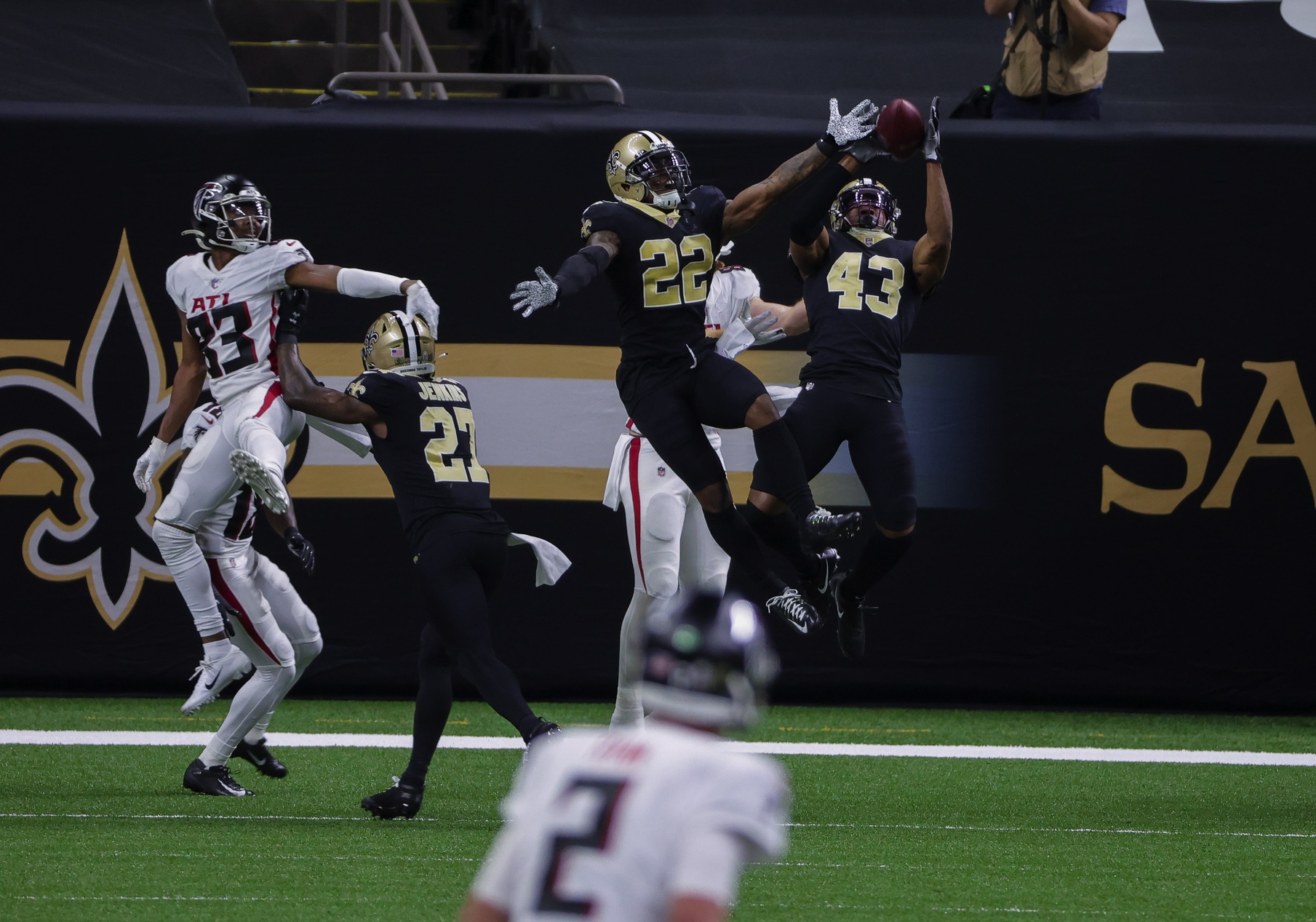
NEW ORLEANS SAINTS: S Marcus Williams
It could have been easy for Marcus Williams to feel extremely deflated and down on himself following the infamous “Minneapolis Miracle” play in the 2017 NFC divisional round, when he badly missed a tackle on then-Vikings WR Stefon Diggs to lose the game in heartbreaking fashion (a Saints playoff tradition ever since).
Instead, Williams took his game to the next level, ranking 10th among all safeties in coverage grade in the three seasons following that unfortunate mishap.
With all of that said, it’s hard to envision the Saints being able to dole out a big contract to anyone this offseason considering they’re currently projected to be $96 million over the current minimum $175 million salary cap.
NEW YORK GIANTS: DI Dalvin Tomlinson
This was a toss-up between two maulers up front for the Giants — Leonard Williams and Dalvin Tomlinson. Though Williams offers more pass rush upside (he broke out in a big way and was tied for third among interior defenders in 2020 with 62 total pressures), he will also likely command a deal much more substantial than that of Tomlinson, a nose tackle.
Williams could be looking for $20M or more per year on a long-term contract, whereas Tomlinson will probably land somewhere in the $15M per year range.
With 2019 first-round pick Dexter Lawrence getting better and better each week, New York should feel comfortable with a duo of Lawrence and Tomlinson going forward, even though Williams undoubtedly would be a huge loss.
The Giants acquired Williams via trade from the Jets for a third- and fifth-round pick, which may cause them to buy into the notion of sunk cost, but Lawrence would undoubtedly sign a contract elsewhere with a third-round compensatory pick value.
NEW YORK JETS: S Marcus Maye
This is an obvious one, and the Jets can now feel more comfortable extending one great safety knowing they don’t need to back up the brinks truck for two, thanks to Seattle sending two first-round picks to New York for Jamal Adams.
Maye, the Jets’ second-round pick in 2017 after taking Adams No. 6 overall, has emerged as one of the top free safeties in the NFL. While he’s not quite the pass rusher Adams is — no safety is — he’s a jackknife in his own right, no question.
Maye led all safeties in snaps in 2020 and played down in the box for a quarter of them, at slot corner for roughly 15% and at free safety the rest of the time. He’s an extremely important piece of this secondary going forward as the Jets work to solidify the safety and cornerback positions around him.
PHILADELPHIA EAGLES: HC Doug Pederson
The Eagles went all-in on a veteran roster, seeking to repeat their 2017 Super Bowl run. As a result, they effectively don’t have any significant free agents. This isn’t all bad, as they aren’t going to lose any valuable contributors from the 2020 roster unless they choose to move on.
Filling the void at head coach thus becomes the clear top priority.
PITTSBURGH STEELERS: CB Cameron Sutton
While the Steelers have a handful of big-name free agents, ED Bud Dupree and WR JuJu Smith-Schuster among them, it’s unlikely Pittsburgh will be able to dole out the big bucks for anyone. For that reason, ensuring that their coverage unit can maintain a high-level of play should be their focus.
CB Joe Haden will be 32 years old in 2021 and is coming off his lowest-graded season since 2016. He was still solid with a 66.6 overall grade and 69.6 coverage grade, but there’s an outside chance he ends up a cap casualty in 2021, even with an $8.575 dead money charge.
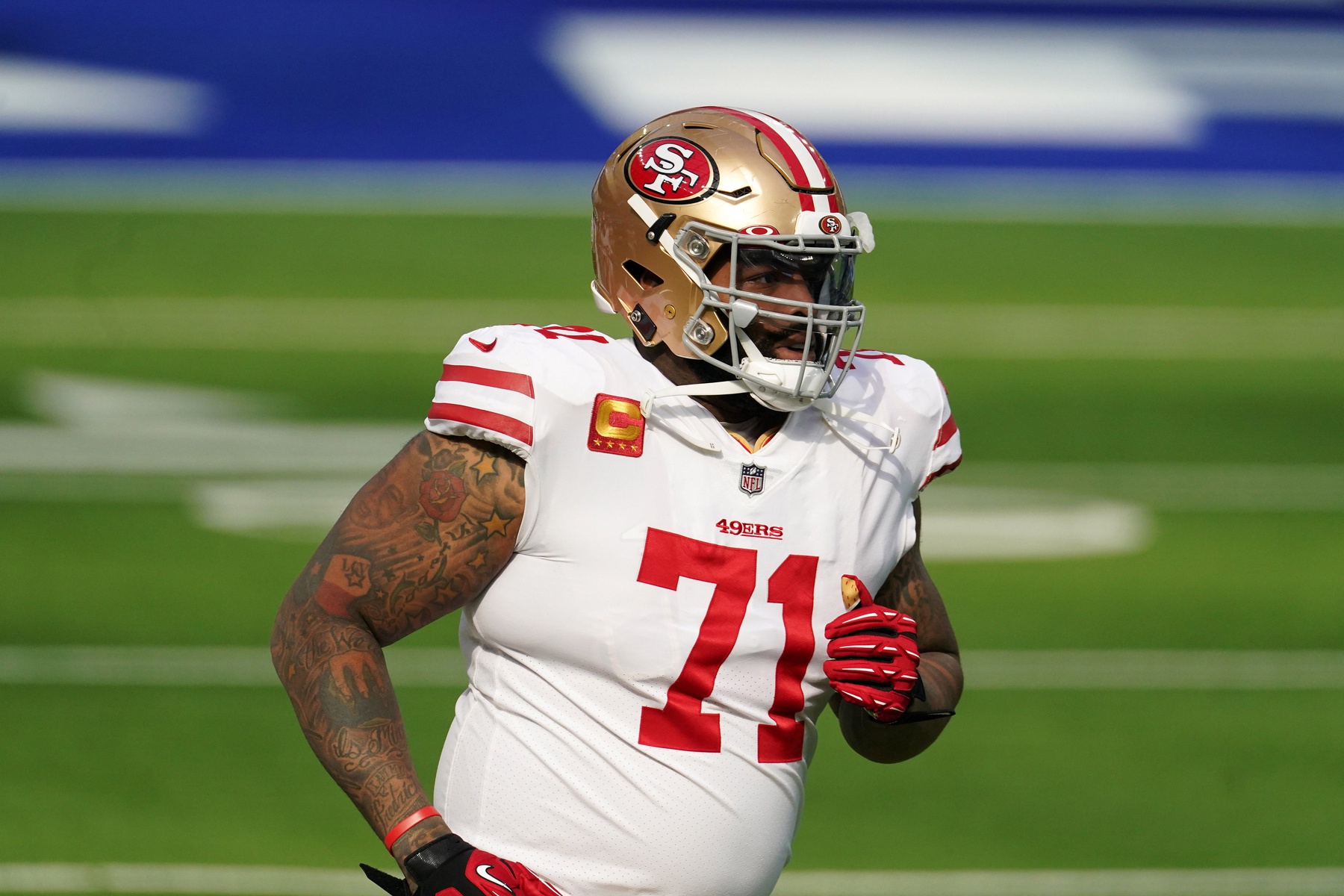
SAN FRANCISCO 49ERS: T Trent Williams
The 49ers pulled off a draft-day heist (something they’ve been quite good at in recent years) in acquiring Trent Williams from the Washington Football Team in exchange for a 2020 fifth-round and 2021 third-round pick.
Williams’ extended absence from playing football was not evident on tape whatsoever, as he returned to form as one of the best tackles in the NFL. Williams had the highest run-blocking grade in the league among tackles (91.5) — an extremely important skill in Kyle Shanahan’s outside zone run scheme. In addition, Williams also ranked ninth in pass-block grade at 85.6.
It’s truly staggering that Williams could play at this high of a level after a full year off and with a new team, especially after a limited offseason. Players this good are very hard to let go.
Working in San Francisco’s favor if they do decide to move on is the fact they will most likely earn a third-round compensatory pick in 2022 when (not if) Williams signs a massive deal elsewhere. So they can recoup the majority of their trade investment if they view Williams as just a rental.
SEATTLE SEAHAWKS: LB K.J. Wright
With the Seahawks selecting Texas Tech LB Jordyn Brooks in the first round of the 2020 NFL Draft, there appeared to potentially be writing on the wall for Wright’s future in Seattle. Wright, to his tremendous credit, more than took that development in stride.
After a career-low 53.9 coverage grade in 2019, it was clear that Wright's days as a weakside linebacker were numbered. The 31-year-old transitioned into a strongside linebacker role in the Seahawks' base 4-3 scheme, playing more snaps on the defensive line in 2020 than he had in all seven seasons from 2013-2019 combined.
Wright was one of the few bright spots on the Seahawks defense and now offers the ability to play two spots were that to become necessary as a result of injuries.
TAMPA BAY BUCCANEERS: WR Chris Godwin
Godwin was already recognized as one of the best young wide receivers in the NFL prior to the 2020 season, and while he did not have his best statistical season, he exemplified other traits that should make Tampa even more bullish on his long-term outlook.
Godwin battled through various injuries, and his toughness impressed HC Bruce Arians, among others within the organization. Godwin is fearless running routes out of the slot over the middle of the field, and if the Buccaneers want to make another run at a Super Bowl in 2021 before Tom Brady ends his remarkable career, Godwin would go a long way toward getting them there.
TENNESSEE TITANS: TE Jonnu Smith
Even though Smith was not consistently utilized throughout the season (five games with only two targets), he makes the absolute most of the targets he does see. Since 2019, Smith’s 6.8 yards after the catch per reception ranks fifth among all tight ends with at least 25 targets, and his 11 touchdowns are tied for sixth.
The Titans’ other primary tight end, Anthony Firkser, is very capable in his own right. He’s also a free agent this offseason. But Smith is the dynamic athlete at tight end that can create explosive plays in the passing game.
We’re sure many expected Corey Davis’ name to be listed here, and he undoubtedly had a remarkable season, but the Titans should be preparing to offer WR A.J. Brown a monster extension soon.
WASHINGTON FOOTBALL TEAM: G Brandon Scherff
While Scherff did still miss a few games in 2020 — a fair concern considering he missed a handful of games in 2018 and 2019 as well — the sprained knee he suffered kept him out just three weeks, and he was back to form.
In the five weeks following his return from injured reserve, Scherff’s 79.4 overall grade ranked fifth among all guards. It’s safe to say he put the injury behind him, and Washington should have no concern signing him to the big, long-term extension he’ll be seeking for the third straight offseason.
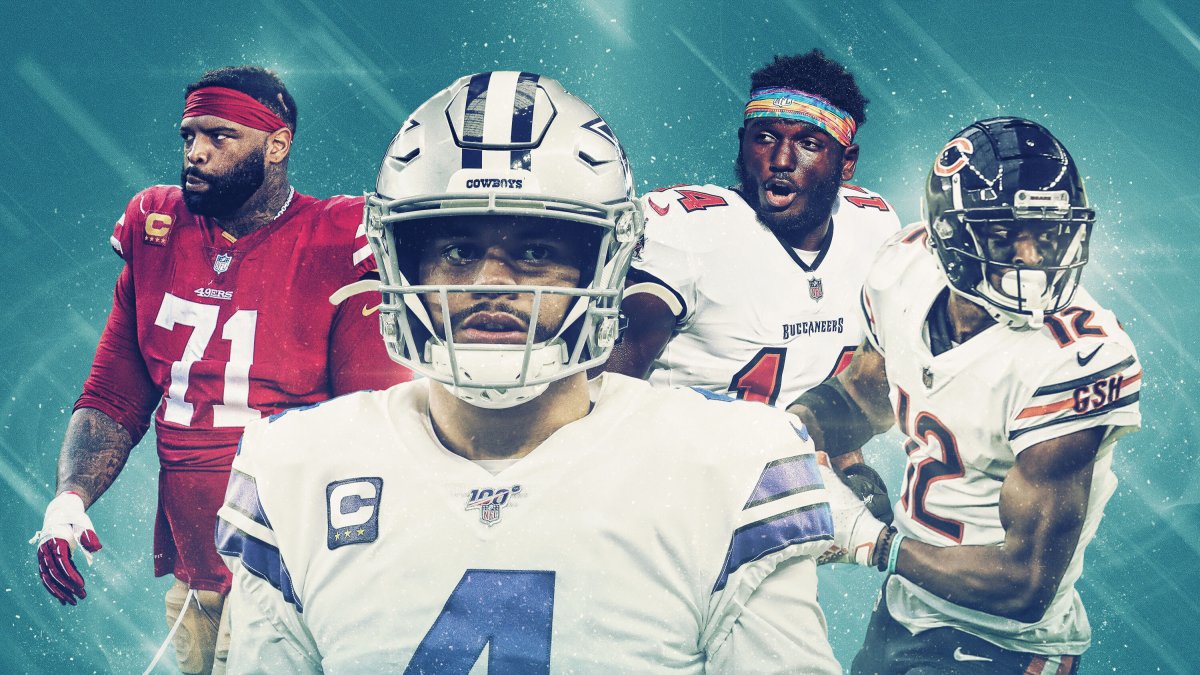


 © 2025 PFF - all rights reserved.
© 2025 PFF - all rights reserved.